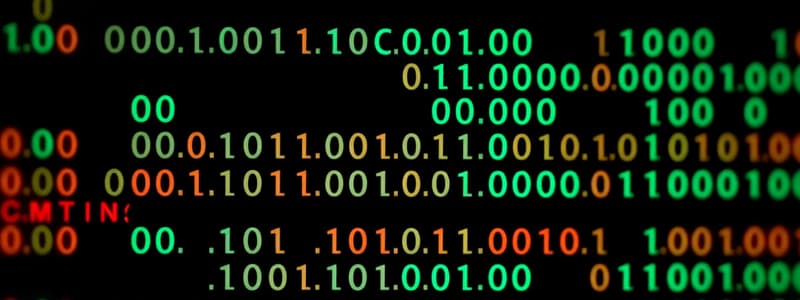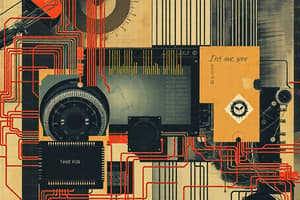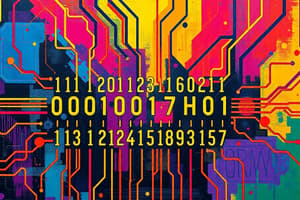Podcast
Questions and Answers
What characterizes reflective codes in binary representation?
What characterizes reflective codes in binary representation?
- The code for 9 complements the code for 0. (correct)
- Each digit is weighted according to its position.
- They allow error detection and correction.
- The codes are sequentially increasing binary numbers.
What is the main feature of non-weighted codes compared to weighted codes?
What is the main feature of non-weighted codes compared to weighted codes?
- They do not assign specific weights to each digit. (correct)
- They are always self-complementing.
- They are used solely for error detection.
- Each position has an associated weight.
Which statement is true regarding BCD (Binary-Coded Decimal) representation?
Which statement is true regarding BCD (Binary-Coded Decimal) representation?
- Each decimal digit requires 3 bits in BCD.
- BCD can represent decimal numbers 10 and above.
- Decimal numbers 0 to 9 are represented identically in BCD and binary. (correct)
- Binary combinations 1010 through 1111 have specific meanings in BCD.
Which type of code indicates that each succeeding 'code is greater than the previous one?
Which type of code indicates that each succeeding 'code is greater than the previous one?
How many bits are necessary in BCD to represent a decimal number with k digits?
How many bits are necessary in BCD to represent a decimal number with k digits?
What is the primary benefit of using Gray Code in digital communication?
What is the primary benefit of using Gray Code in digital communication?
Which of the following statements about Hamming codes is accurate?
Which of the following statements about Hamming codes is accurate?
When using parity bits to detect errors, which of the following is true?
When using parity bits to detect errors, which of the following is true?
In the context of the relationship between data bits and parity bits in Hamming code, which of the following inequalities is correct?
In the context of the relationship between data bits and parity bits in Hamming code, which of the following inequalities is correct?
How are Hamming codes constructed with respect to data bits and parity bits?
How are Hamming codes constructed with respect to data bits and parity bits?
Flashcards are hidden until you start studying
Study Notes
Digital Codes
- Digital data is represented, stored and transmitted as groups of binary digits also known as binary code.
- Weighted codes: Each digit is assigned a specific weight according to its position.
- Non-weighted codes: Codes not appositionally weighted.
- Reflective codes: The code is self complementing.
- Sequential codes: Each succeeding 'code is one binary number greater than its preceding code.
- Alphanumeric codes: Codes used to represent numbers, alphabetic characters, symbols
- Error defecting and correcting codes: Codes which allow error defection and correction are called error detecting and correcting codes.
Classification of Codes
- Numeric Codes
- Binary Coded Decimal (BCD): Each decimal digit is represented by a 4-bit binary code.
- A decimal number in BCD is the same as its equivalent binary number only when the number is between 0 and 9.
- Other Decimal Codes
- Gray Code: Only one bit changes between two consecutive codes.
- Useful for analog-to-digital conversion, error detection and low power design.
- Error-Detecting Codes
- Parity: An extra bit is added to a message to make the total number of '1's either even or odd.
- Hamming Code: Uses multiple parity bits to detect and correct errors.
- It can detect and correct one-bit errors in a data block.
- The number of parity bits needed depends on the number of data bits.
- Alphanumeric Codes
- Standard BCD Code: Uses 6 bits to represent a character, up to 64 characters.
- Used in specific digital systems.
- Extended Binary Coded Decimal Interchange Code (EBCDIC): Used primarily on IBM medium and large computers.
- Uses 8 bits to represent a character, up to 256 characters.
- American Standard Code for Information Interchange(ASC-II): Used on personal computers.
- Uses 7 bits to represent a character, up to 128 characters.
- For communications, it uses 8 bits with an added parity bit.
- Standard BCD Code: Uses 6 bits to represent a character, up to 64 characters.
Hamming Code
- Can detect and correct a single bit error using parity bits
- Parity bits are positioned at powers of 2 (1, 2, 4, 8, ...)
- Parity bits are calculated by XORing the data bits they cover.
- To detect errors.
- Calculate the parity bits for the received data
- If any parity bits don't match the original, an error has occurred
- The number of parity bits that are incorrect gives the location of the error.
Error Detection
- Parity Checking: Detects errors by checking if the number of '1's is even or odd.
Error Correction
- Hamming Code is an example of an error-correcting code.
- It uses multiple parity bits to detect and correct an error.
- Check bits (parity bits) are used to detect and correct errors.
- Data bits are the bits that carry the actual information.
Standard BCD Code
- Uses a 6-bit structure:
- 1 zone bit
- 5 digit bits.
- Supports characters from A to I (0001
1001), J to R (00011001), S to Z (00101001), 0 to 9 (00011010), and other special characters.
EBCDIC Code
- Uses an 8-bit structure:
- 1 parity bit
- 4 zone bits
- 4 digit bits
- It is used on IBM mainframes.
- It includes a wide range of characters, including control characters, special characters, lowercase letters, uppercase letters, and numeric digits.
ASC-II Code
- Most common character encoding system used today.
- It uses a 7-bit structure:
- 1 parity bit
- 3 zone bits
- 4 digit bits
- Supports characters from 0 to 9, a to z, A to Z, and various special characters.
Studying That Suits You
Use AI to generate personalized quizzes and flashcards to suit your learning preferences.




